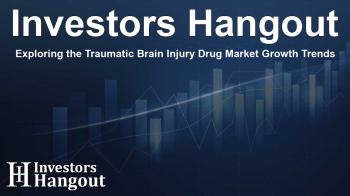Exploring the Traumatic Brain Injury Drug Market Growth Trends

Understanding the Traumatic Brain Injury Market Landscape
Pharmaceutical companies are increasingly investing in drug development for traumatic brain injuries (TBI). Despite a limited late-stage pipeline, there are promising early-phase clinical trials in progress. This evolving research landscape demonstrates a shift towards a more comprehensive understanding of TBI, particularly mild traumatic brain injuries (mTBI), which were previously overlooked.
Recent trends show a growing focus on mild TBI, reflecting a significant transformation in how these injuries are diagnosed and treated. As awareness increases, the healthcare sector is ramping up investments in therapies aimed at restoring cognitive function and improving quality of life for those affected by TBI.
Market Insights and Growth Projections
Current analysis indicates that the traumatic brain injury market generated approximately USD 1.3 billion in revenue within key markets for the year 2024. The United States continues to dominate this market, accounting for about 85% of total revenue, with expectations for notable growth in the following years.
Key Market Dynamics
Advancements in diagnostic tools such as CT and MRI have enabled quicker and more accurate detection of neuro-traumatic disorders. These technologies are invaluable in the immediate moments following an injury, providing critical data that influences patient management.
In 2024, the introduction of AKUUGO marked a significant milestone, being approved as the first cell therapy for TBI treatment. This innovation highlights the evolving narrative around TBI treatments and will likely pave the way for further breakthroughs.
Emerging therapies, particularly OXE103, are projected to capture significant market share by 2034. The analytical landscape also identifies approximately 4.3 million new TBI cases identified each year in the targeted markets, with predictions suggesting this number could rise to 4.5 million by 2034, particularly affecting male patients.
Emerging Therapeutics and Pipeline Prospects
The future of the TBI treatment market looks promising with multiple companies developing innovative therapies. Leading firms, including Oxeia Biopharmaceuticals and Hope Biosciences, are at the forefront, creating novel drug formulations that aim to address the complex needs of TBI patients.
Significant pipeline therapies like OXE113, HB-AdMSCs, and ONP-002 are being investigated and demonstrate potential in improving patient outcomes. As the treatment landscape expands, it is essential for these firms to effectively market their findings and maintain compliance with regulatory processes.
Challenges and Barriers to Treatment
Despite these advancements, the TBI market faces considerable challenges. Up to 30% of concussion patients experience persistent symptoms, highlighting the urgency for effective treatment solutions. Currently, no FDA-approved medications are available specifically for acute concussion management, and traditional care often relies on observation and gradual activity resumption.
The regulatory framework further complicates the approval process for new treatments, which can stymie innovation and delay much-needed access to beneficial therapies. Alongside this, issues related to polypharmacy pose additional risks, increasing the likelihood of interactions that could detract from treatment efficacy.
Strategies for Future Growth
Enhanced collaboration between investors, developers, and academic researchers is vital to advance TBI treatment strategies. Raising awareness about the prevalence of mild TBI in populations, including military personnel and athletes, is crucial to drive change and cultivate a more effective response to this widespread condition.
As the focus on TBI evolves, the medical community is poised to address the unmet needs of patients living with these injuries. By innovating treatment methodologies and increasing patient access to clinical trials, the future of the traumatic brain injury market looks bright.
Frequently Asked Questions
What is the current market size of the traumatic brain injury market?
The traumatic brain injury market size was estimated at approximately USD 1.3 billion in 2024.
What are some of the new therapies being explored for TBI?
Emerging therapies include OXE103, HB-AdMSCs, and ONP-002, which are undergoing clinical trials to evaluate their efficacy.
Why is there increased interest in mild traumatic brain injuries?
Growing recognition of the long-term consequences of mild TBI and the need for effective treatments have led to increased focus on this previously overlooked area.
What are the main challenges in treating TBI?
Challenges include the lack of FDA-approved treatments for acute concussion, regulatory hurdles, and complications arising from polypharmacy.
How can patients access the latest therapies for TBI?
Patients can participate in clinical trials or seek information about emerging therapies through healthcare providers and research institutions.
About The Author
Contact Lucas Young privately here. Or send an email with ATTN: Lucas Young as the subject to contact@investorshangout.com.
About Investors Hangout
Investors Hangout is a leading online stock forum for financial discussion and learning, offering a wide range of free tools and resources. It draws in traders of all levels, who exchange market knowledge, investigate trading tactics, and keep an eye on industry developments in real time. Featuring financial articles, stock message boards, quotes, charts, company profiles, and live news updates. Through cooperative learning and a wealth of informational resources, it helps users from novices creating their first portfolios to experts honing their techniques. Join Investors Hangout today: https://investorshangout.com/
The content of this article is based on factual, publicly available information and does not represent legal, financial, or investment advice. Investors Hangout does not offer financial advice, and the author is not a licensed financial advisor. Consult a qualified advisor before making any financial or investment decisions based on this article. This article should not be considered advice to purchase, sell, or hold any securities or other investments. If any of the material provided here is inaccurate, please contact us for corrections.

